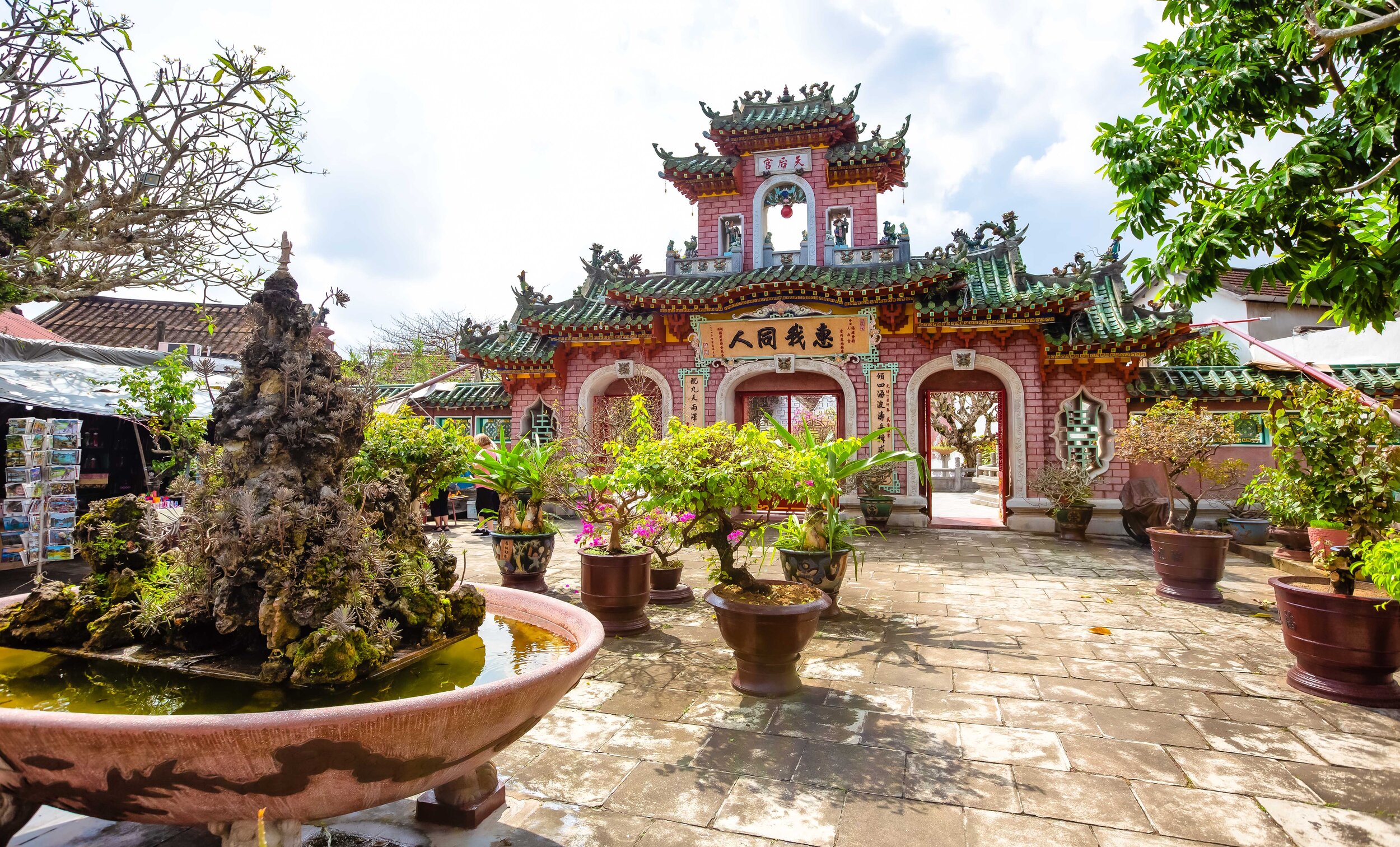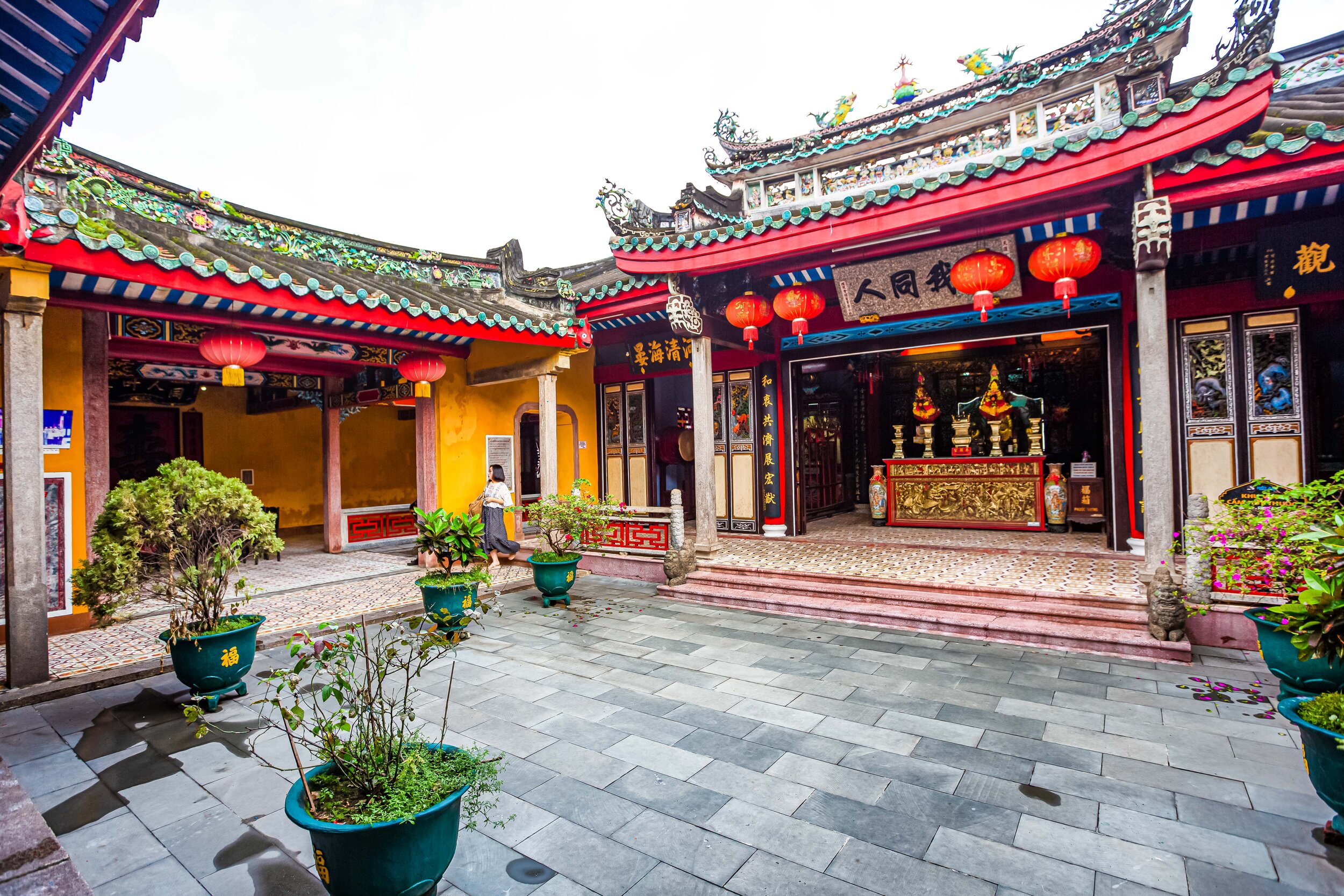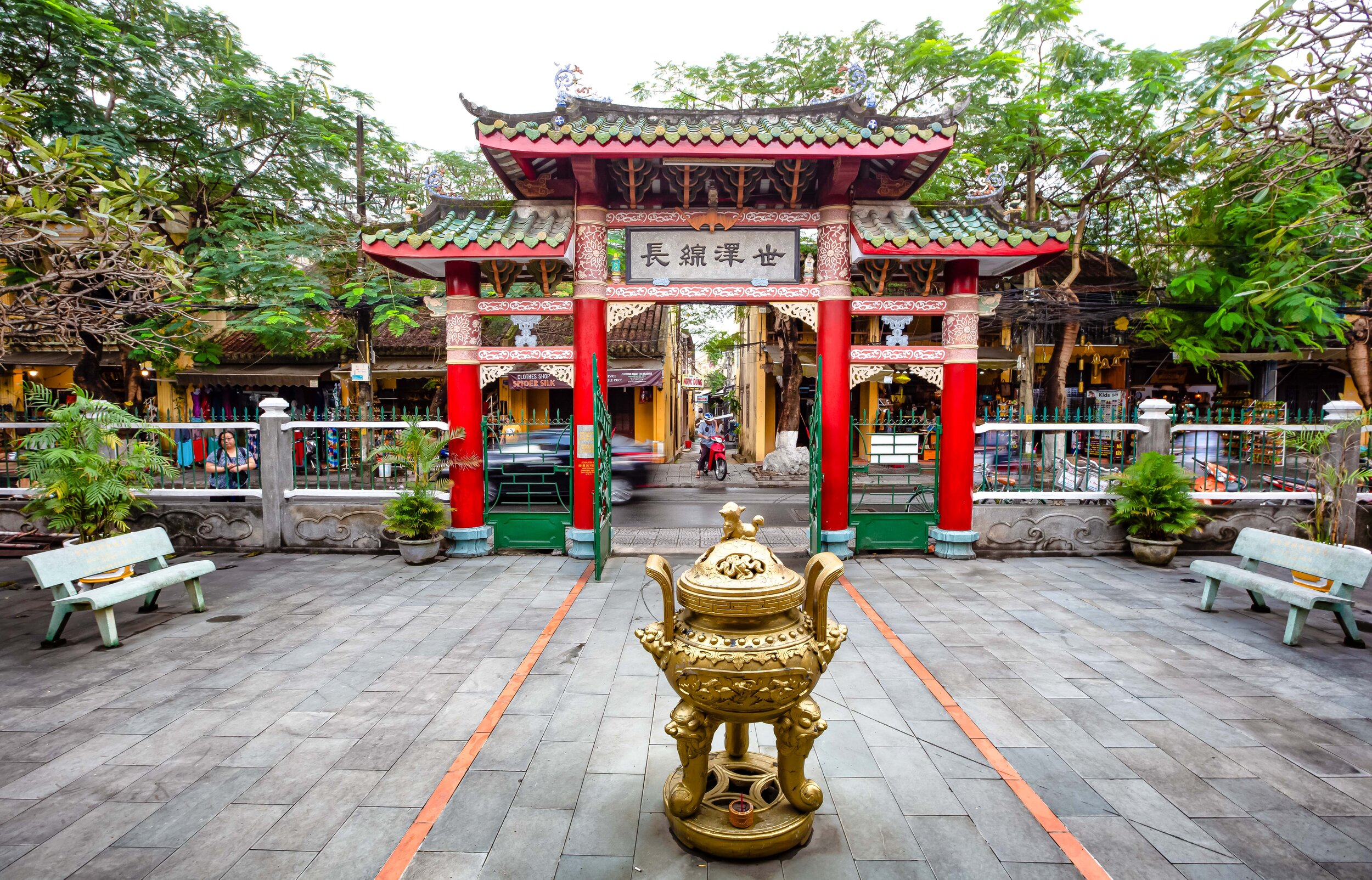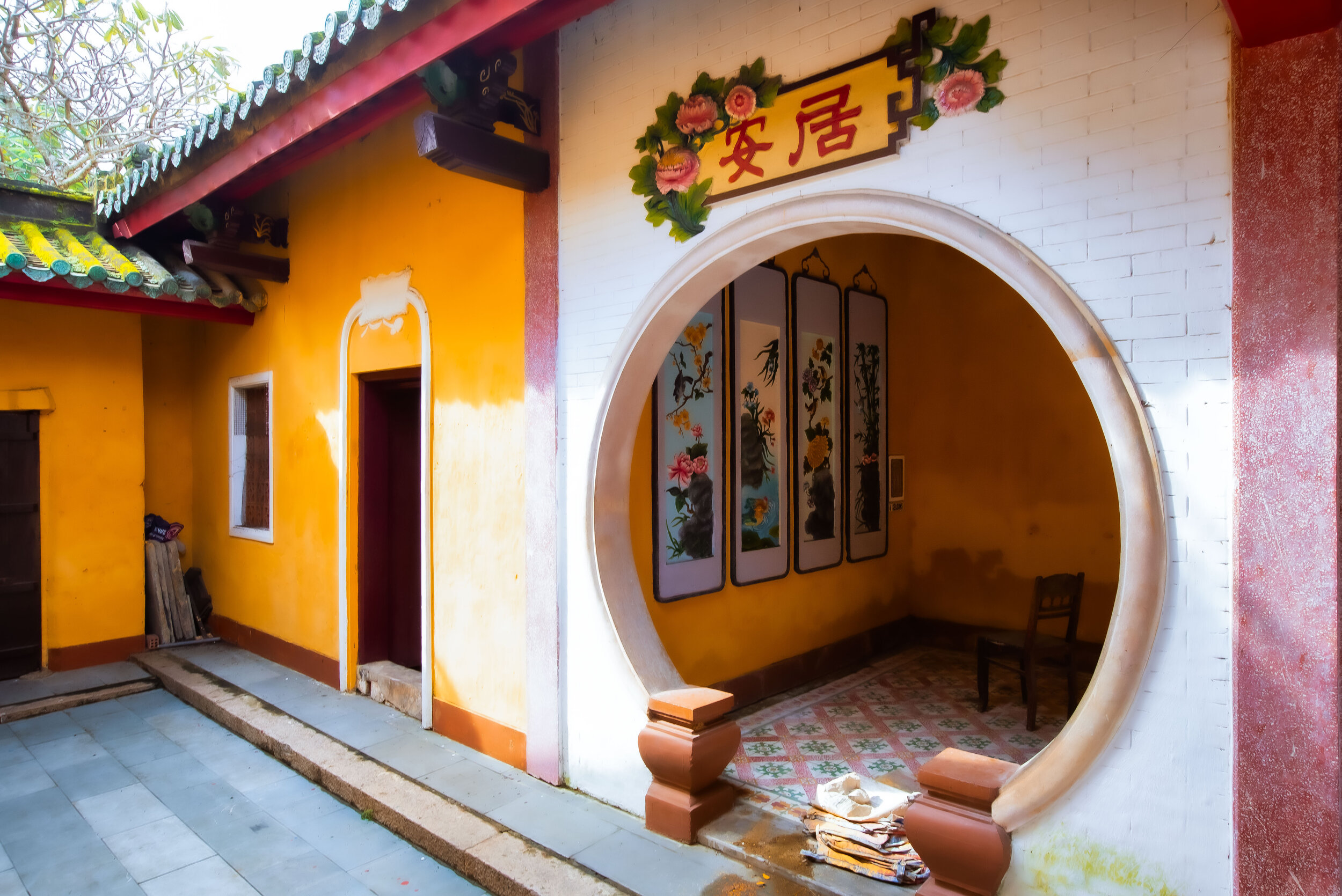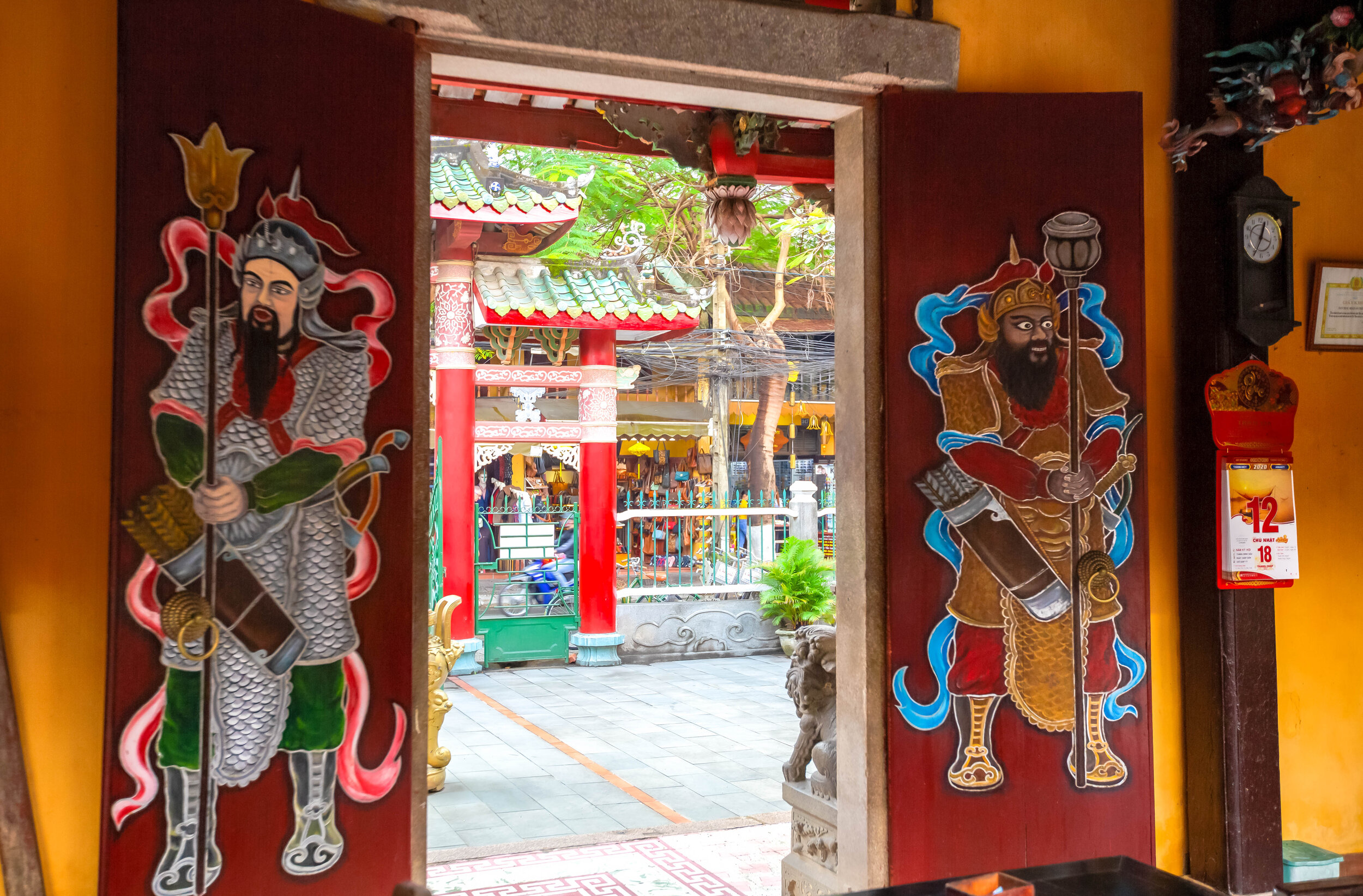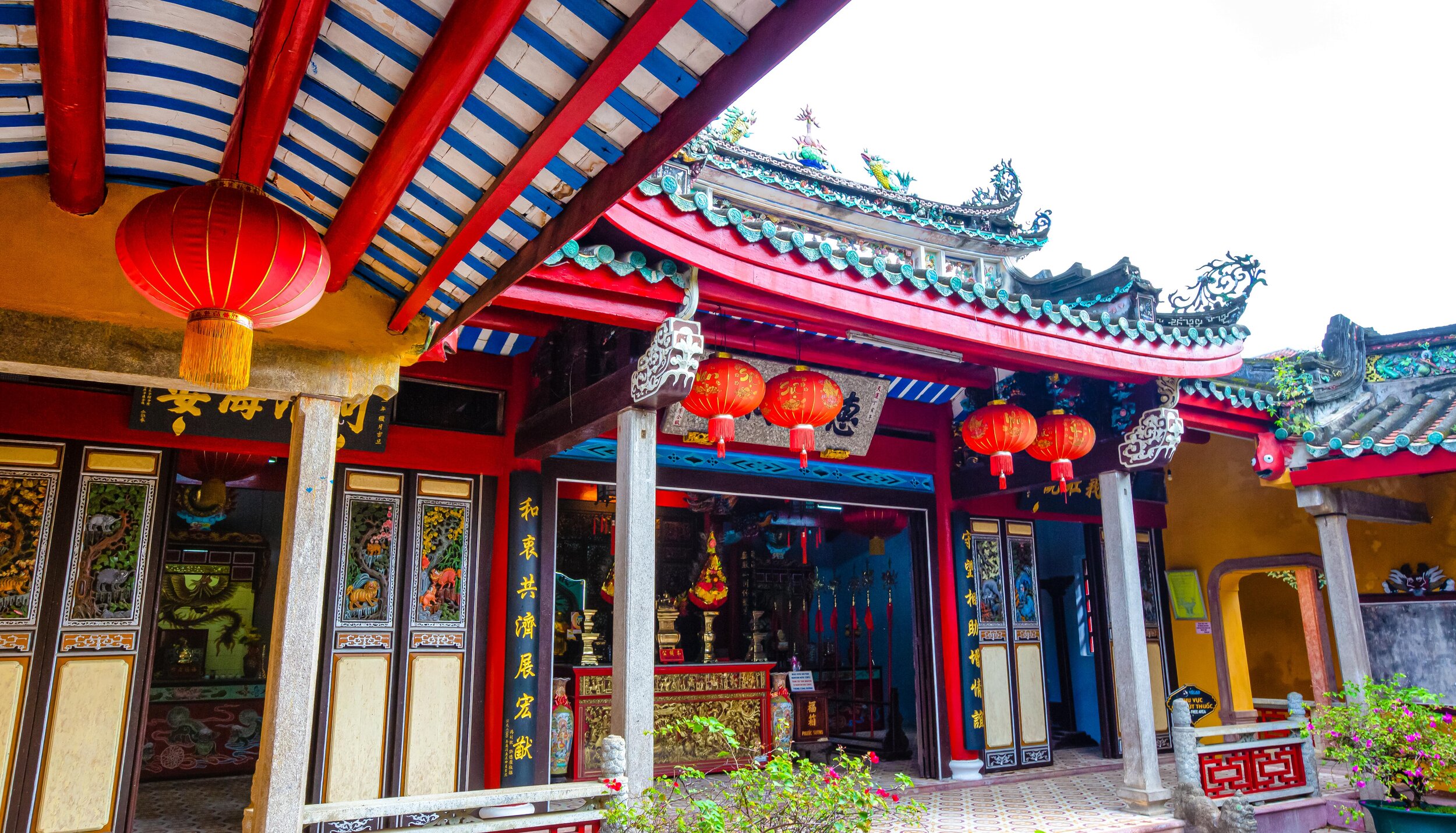While planning my trip to Hoi An, the destinations that had me the most excited were the Overseas Chinese Assembly Halls situated throughout the historic quarter of the city. The hall that I anticipated visiting the most though was the amazingly beautiful Fujian Assembly Hall.
As one of the most popular tourist destinations in Hoi An, the average traveller would probably also enjoy this one as its one of the most historic of the bunch, its also the largest and most beautiful.
When it comes to this kind of thing though, I’m not the average tourist.
Of course I respect that long history and its size but the main attraction for me was the relative familiarity that I could enjoy while visiting. Here in Taiwan, where I live, the Hokkien people make up a large part of the population and their culture, architecture and folk-religion have helped to shape Taiwan into the beautiful country that it is today.
So, a visit to the Fujian Assembly Hall in Hoi An would give me the perfect opportunity to compare and contrast the experience of the immigrant Hokkien population in Vietnam to that of what I’m familiar with in Taiwan. What I looked forward to most though weren’t the similarities but the subtle differences and how the Hokkien immigrants adapted to their new home in Vietnam.
And hey, lets not forget the added bonus that not only is the Fujian Assembly Hall an important meeting place for the Hokkien people of Hoi An - It also serves as the “Mazu Temple” (會安天后宮) of Hoi An, making it a popular stop for all of the people around East Asia that worship the Goddess of the Sea.
If you’d like to learn more about “Assembly Halls” before reading about this one, I recommend reading my earlier post about the Chinese Assembly Halls of Hoi An where I describe them in more detail.
Phúc Kiến Assembly Hall (會安福建會館)
The Fujian Assembly Hall is the hands down the most popular, the largest, the most beautiful and the most historic of all the Overseas Chinese Assembly Halls in Hoi An.
Given that Hoi An has become such a popular tourist destination, you’d think that you’d be able to find quite a bit of information about the hall online - Unfortunately that isn’t the case and a lot of the information that is available is unfortunately not all that accurate.
I hope to clear some of that up here.
The first thing you’ll want to know is that “Phúc Kiến” refers to “Fujian” (福建省), a coastal province in Southern China and the Assembly Hall was constructed by the immigrants who hailed from that specific area. Known as the “Hokkien” or the “Minnan” (閩南人), the people of Fujian speak their own distinct dialect and are well-known for their prowess when it comes to architectural design.
In fact, some of the most impressive Chinese-style architecture hails from the area and when many of us in the west think of ‘oriental’ design, what likely comes to mind is something that was constructed with Hokkien-style design.
With this particular hall, the Hokkien people brought their skills with them and constructed what is arguably one of the most beautiful buildings in the entire city.
One of the biggest misconceptions about the hall is its age.
The area where the hall exists today was originally home to a Buddhist temple named the “Golden Mountain Temple” (金山寺) that was constructed by the local people in Hoi An. The temple was constructed around 1690 but after several decades of use, the temple became run down and the land was purchased by a group of Fujian immigrants who were doing business in Hoi An.
After a period of renovation and a complete redesign of the exterior of the temple, the Fujian Assembly Hall reopened in 1759. With its Hokkien-style architecture, the Assembly Hall became not only one of the most beautiful buildings in Hoi An, but it was also one of the busiest thanks to the amount of Hokkien immigrants and of course, the success of the economy.
So no, the hall isn’t over 330 years old, its about 260 years old.
Still, thats pretty old, especially if you consider everything that has taken place in Vietnam over the past century.
Design
One of the things that makes this Assembly Hall stand out from the others around Hoi An is not only its long history but the amazing attention to detail in its traditional design - The people of Southern China, especially those from Fujian are known for their exceptional architectural design as well as the decorations placed throughout their homes and places of worship and that is something that stays true with this hall.
Like all of the Assembly Halls in Hoi An, the Fujian Assembly Hall is designed with tradition in mind, but one of the things that makes this one stand out is its beautifully designed gate which is visible from the street.
The Assembly Hall consists of the following:
Main Gate (大門) - the gate that meets the street
Courtyard (前院) - the area between the front gate and the middle gate.
Three-Arch Gate (三觀) - a beautifully decorated ‘Pailou Gate’ (牌樓).
Pond (水池) - an artificial pond in the courtyard in front of the Main Hall.
Main Hall (正點) - The “Heavenly Goddess Temple” area.
East and West Halls (東西兩排屋子) - The areas reserved for community-related functions.
Rear Garden (後院) - A small garden between the front and rear hall.
Rear Hall (後殿) - The area reserved for ancestral worship.
Once you’ve passed through the front gate, if you’re like most people, your eyes will automatically be drawn to the ornamental gate ahead of you. The three-arched gate, which is known as a “paifang” (牌坊), was constructed in traditional Southern-Chinese fashion and consists of a seven-layered roof that is beautifully decorated with ornamental dragons, lions and other mystical creatures. The gate was a later addition, which should be fairly obvious given how pretty it is.
I’m not confident about its age, but from what I found while doing research, it’s likely that this gate and the front gate were added sometimes around 1975 when the hall was undergoing a period of restoration.
Above the doors you’ll find a beautifully designed plaque with the Chinese characters for “Fujian Assembly Hall” (福建會館) crafted using (a variation on) the ancient Chinese Seal Script (篆書). Just above the plaque is an open space where there is a dragon’s head with the sun in its mouth. On both the left and right you’ll also find statues of men holding the Chinese characters for “moon” (月) and “sun” (日) which form together to make “Yin” and “Yang” (陰陽) and a peaceful natural balance.
One interesting thing that a lot of people people miss about the gate is that there is another plaque on both the top of the front side and the back side of the gate. On the front you’ll find the Chinese characters for “Golden Mountain Temple” (金山寺) while on the opposite side you’ll find the characters for “Heavenly Goddess Temple” (天后宮), which is a nod to the past and present of this Assembly Hall.
Once you’ve passed through the gate, you’ll find yourself within the inner courtyard of the Assembly Hall.
This courtyard has quite a bit of potential, especially if they filled it with tropical flowers or plants, but when I visited I found that it was unfortunately run down and in need of some attention. There are however quite a few cute stray dogs that hang out and they’re quite friendly, so that was enough for me.
When you reach the entrance of the main hall, it’s important to stop and take a moment to appreciate the architecture of the more than 250 year old facade of the building. Constructed in the traditional Hokkien style, you’ll notice that it is beautifully decorated with porcelain carvings (剪瓷雕) featuring dragons, phoenixes, turtles, fish, etc.
Even though some of the decorations on the roof have faded with age, the carvings on the lower section have recently been repainted.
One of the most prominent features of Hokkien architectural design is the “Swallowtail Roof” (燕尾脊), which has an upward-curved ridge, shaped like the tail of a swallow (a kind of bird). In the case of this Assembly Hall, the ridge is split into two separate tiers with the lower section curving at a much higher degree than the upper section.
Most of the Assembly Halls you’ll find in Hoi An follow a similar formula in terms of the roof design, but that shouldn’t surprise you as the Hokkien style spread throughout Southern China. The thing that differentiates the hall from others in town though are (in part) thanks to the decorations that you’ll find on the roof. This may seem like a minor difference to the untrained eye, but is actually an important distinction in terms of the different cultures.
I should warn you that one of the things that you’re going to notice as you walk into the main hall are the giant incense coils hanging from the ceiling. The incense, which is locally made in Hoi An is quite fragrant, but if you’re sensitive to this kind of thing, you might feel a little uncomfortable. Fortunately there is an open-air roof, so the smoke shouldn’t be too overpowering.
Once inside you’ll notice that the “Assembly Hall” sections of the building are situated on the eastern and western sides while directly in front of you is main attraction, the “Heavenly Goddess Temple.”
During my visit, the people at the hall were getting ready for the annual “Tet” Lunar New Year holiday, so part of the Assembly Hall area was used for food donations for those less fortunate. They had massive stacks with bags of rice and other types of food that were donated by locals.
There is also an administration area where the people who run the building hang out, drink tea, watch tv and chat with friends. The majority of the “Assembly Hall space though is empty and used for storage for the massive coils of incense that are constantly being lit.
Tian Hou Temple (天后宮)
Even though this is considered the “Fujian Assembly Hall”, the actual “assembly” part of the building is almost completely overshadowed by the “Heavenly Goddess Temple” (天后宮).
If you weren’t already aware, the “goddess” refers to the immensely popular Hokkien goddess Mazu (媽祖), who is known as “Thien Hau” (天后) in Vietnam.
Here in Taiwan there more than three-thousand temples dedicated to Mazu, the goddess of the sea. Her worship though has spread throughout the world and you’ll find temples dedicated to her throughout China, Japan, South East Asia and anywhere the Hokkien people have immigrated.
It would be an understatement to say that Mazu worship is a huge thing here in Taiwan, but in Vietnam it is something that has transcended cultural traditions, so even though its part of a regional Chinese folk-religion, you’ll still find Vietnamese showing up to the temple to show their respect to the goddess.
Link: Mazu (媽祖)
NOTE: It’s important to remember that in some of the literature that you’ll find about this Assembly Hall is that the temple inside is full of “Buddha” statues. While that’s not entirely false (there’s a statue of Guanyin), Mazu, her guardians and the other deities within are a harmonious blend of Chinese folk-religion, Buddhist and Taoist traditions. As the temple is primarily dedicated to Mazu, it is primarily a Chinese folk-religion place of worship and not Buddhist.
As is tradition, accompanying the goddess you’ll find her two guardian demon friends “Thousand Mile Eye” (千里眼) and “Wind-Following Ear” (順風耳) who are known in Vietnam respectively as “Thien Ly Nhan” and “Thuan Phong Nhi” in Vietnam.
Yes, I realize that their names are direct translations from Chinese, but the green-skinned ‘Thousand-Mile Eye’ keeps his eyes open for danger while the red-skinned ‘Wind-Following Ear’ is always listening. The names are helpful for differentiating them as well as helping people remember what their abilities are.
Together with the Goddess of the Sea, the three deities help to protect people at sea, which obviously would have been especially important for the sea-faring traders going back and forth from China to Hoi An during Hoi An’s heyday as a major trading port.
Link: Qianliyan (千里眼) | Shunfeng’er (順風耳)
The Main Hall is also home to shrines to Guanyin (觀世音菩薩), the Buddha of Compassion as well as the Taoist God of Wealth (財神). Most notably though, the hall is home to a shrine dedicated to the Goddess of Fertility (註生娘娘) and her Twelve Midwives (十二婆姐). This is significant because the temple has become a popular stop for local couples who are having trouble giving birth as well as those who are looking for blessings during their pregnancy.
If you visit, make sure to note the offerings of fruit left by couples - which ironically more often outnumber the offerings left at the main shrine for Thien Hau.
Accompanying the main shrine is a separate shrine in a room off to the side where you’ll find statues of the heads of the original six families who immigrated from Fujian and helped construct the Assembly Hall. You’ll also find ‘Spirit Tablets’ (牌位) dedicated to the generations of people who have lived in Hoi An since then.
Link: Spirit Tablets (神位)
Interestingly in Vietnam there is a subset of the Oversea Chinese community known as the “Minh Hương” (明鄉) who were people who fled China and settled in Vietnam when the Ming Dynasty (明朝) in China was toppled by the Manchu’s. The six statues of the people who founded the Assembly Hall were a part of this group, so if you pay attention you’ll see the Chinese characters above on some of the spirit tablets. The Minh Huong, who are know considered Vietnamese and not ethnic-Chinese coincidentally have their own Assembly Hall, but as some of the first settlers in the Hoi An area, their history and their presence permeates throughout town.
Link: Minh Hương (明鄉) | Minh Huong Communal Hall (Coming Soon)
Even though Vietnam is home to two “official” Heavenly Goddess Temples, this spiritual space set up within the Fujian Assembly Hall (that goes by the same name) has been an important place of worship for the Hokkien immigrants who have settled in Hoi An, helping them to not only keep their cultural traditions alive in the Assembly Hall but their religious practices as well.
The Phúc Kiến Assembly Hall is one of the most popular tourist destinations in Hoi An, so if you’re in the area, this is a must-visit destination. It’s unfortunate that there isn’t much information available in English to explain the history and significance of what you’ll find inside the hall. I hope that this article helps travelers understand a little more of what you’ll see when you visit this beautiful location.
Getting There
Hoi An is a coastal town in Vietnam’s central Quang Nam province that is a 30km drive southeast of neighbouring Da Nang City (峴港市). Since Hoi An has become such a popular destination for travellers, getting to the historic town from Da Nang is quite convenient. Whether you arrive by air through Da Nang International Airport, by train through Da Nang Station or by coach, you’ll be able to easily get yourself to Hoi An through public or private transport, all of which are quite affordable.
While staying in Vietnam, you should also download the “Grab” app for your phone so that you can easily grab a taxi during your travels without having to worry about a language barrier or getting cheated.
Link: Transportation Guide: How to Get from Da Nang to Hoi An
Once you’ve arrived in Hoi An, getting around is really easy - just walk everywhere!
The ‘Old Town’ area of Hoi An that has become a UNESCO World Heritage Site isn’t all that big, and due to so much pedestrian traffic, they’ve blocked the area off from cars, so unless you’re riding a bicycle or a scooter, the best way to get around is on foot.
When you’re ready to start exploring you’ll find that the majority of historic properties, temples, museums and restaurants are located on or between the riverside and Tran Phu Street. What you’ll want to keep in mind though is that exploring the historic properties of Old Town isn’t free, so you’re going to have to purchase an entrance ticket.
The entrance tickets are 120,000 VND (5 USD) per person and gives you access to five sightseeing places. The tickets are valid for the duration of your stay, so if you don’t use all of the tickets on your first day, you’ll still be able to use what you have remaining on the next day.
With so many places to visit within the Old Town though, five tickets might not be enough, so you might have to purchase a second set of tickets if you want to fully experience the town.
Link: Hoi An Old Town Ticket, Entrance Fees & Sites (Hidden Hoi An
Conveniently, as I mentioned above, quite a few of the destinations that you’ll want to visit with Hoi Ann’s Old Town are situated along the stretch of Tran Phu Street. The Fujian Assembly Hall just so happens to be an unmissable part of the street thanks to its grand front gate, its massive size and how different it looks compared to everything else along the street.
Like the Chaozhou Assembly Hall, the Fujian Assembly Hall is located somewhat on the outskirts of the main drag of the old district and is a bit of a distance from other popular destinations like the Japanese Covered Bridge. Still, the pedestrian tourist area of Hoi An isn’t that large, so you won’t have any problem walking back and forth from wherever you plan on visiting.
There are two ticket stalls nearby the Fujian Assembly Hall where you can purchase your tourist pass. The hall is also located nearby the Hoi An Market where you’ll be able to purchase food and drinks. Likewise, the world-renowned (thanks to Anthony Bourdain) Bánh Mì Phượng is a short walk away from the hall. If you’re visiting Hoi An, you’ll definitely not want to miss either the Fujian Assembly Hall or the Banh Mi, so make sure to stop at both!
Address: 46 Trần Phú, Cẩm Châu, Hội An, Quảng Nam, Vietnam
The hall is open from 8:00 am - 5:00 pm daily.







